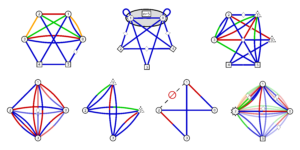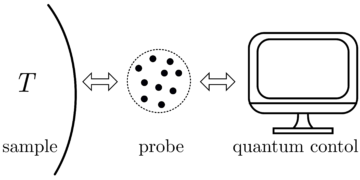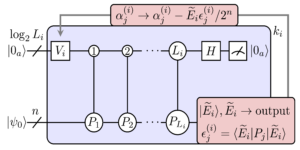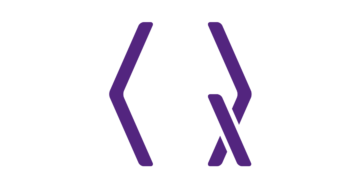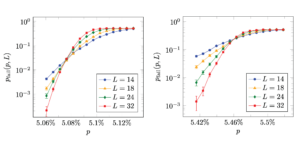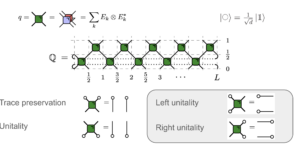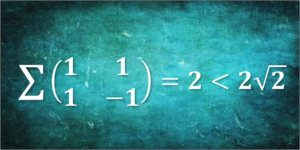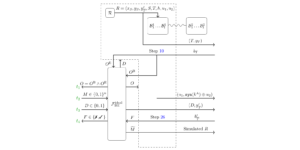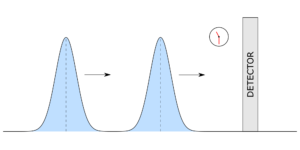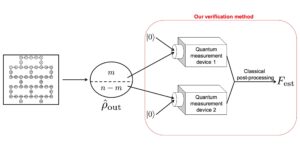Abstract
Previously proposed quantum algorithms for solving linear systems of equations cannot be implemented in the near term due to the required circuit depth. Here, we propose a hybrid quantum-classical algorithm, called Variational Quantum Linear Solver (VQLS), for solving linear systems on near-term quantum computers. VQLS seeks to variationally prepare $|xrangle$ such that $A|xranglepropto|brangle$. We derive an operationally meaningful termination condition for VQLS that allows one to guarantee that a desired solution precision $epsilon$ is achieved. Specifically, we prove that $C geqslant epsilon^2 / kappa^2$, where $C$ is the VQLS cost function and $kappa$ is the condition number of $A$. We present efficient quantum circuits to estimate $C$, while providing evidence for the classical hardness of its estimation. Using Rigetti’s quantum computer, we successfully implement VQLS up to a problem size of $1024times1024$. Finally, we numerically solve non-trivial problems of size up to $2^{50}times2^{50}$. For the specific examples that we consider, we heuristically find that the time complexity of VQLS scales efficiently in $epsilon$, $kappa$, and the system size $N$.
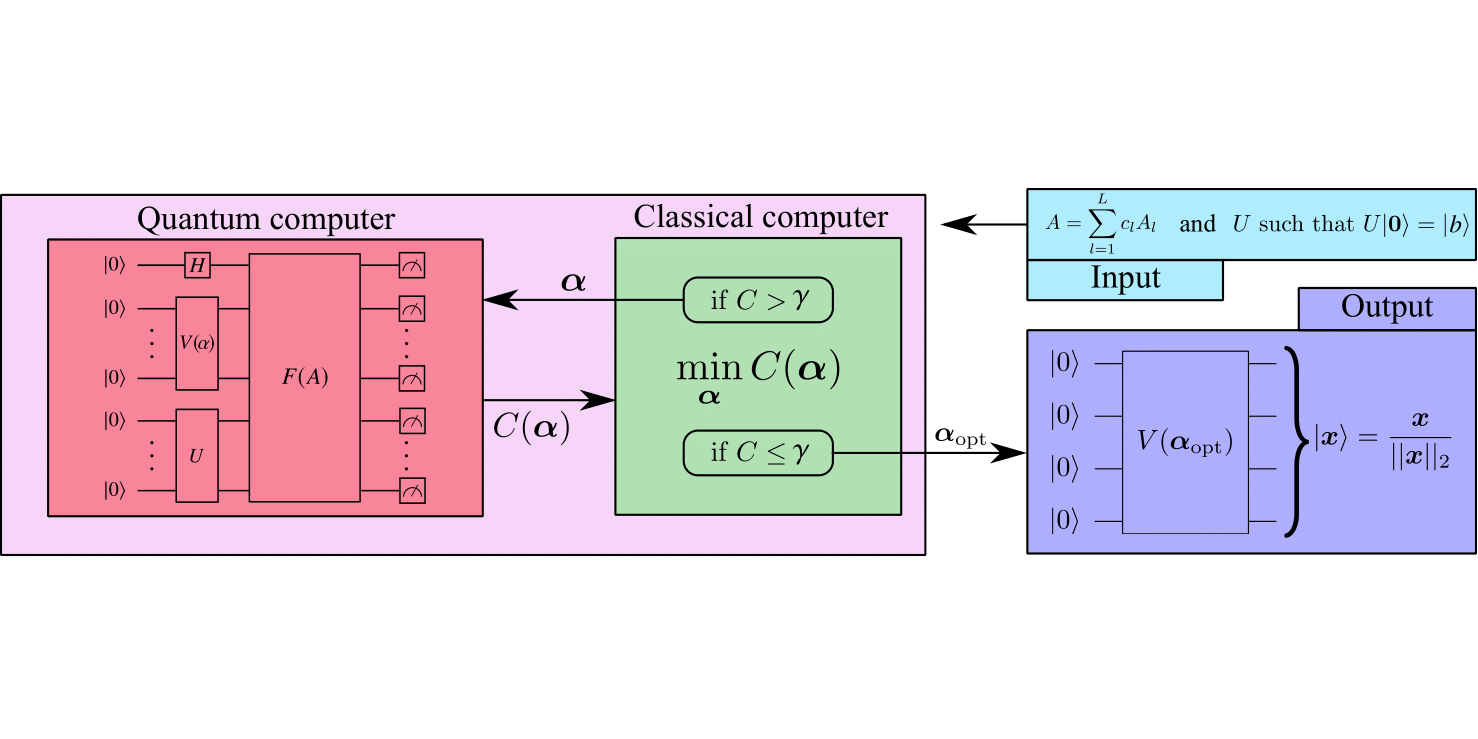
Featured image: Schematic diagram for the Variational Quantum Linear Solver (VQLS) algorithm. The input to VQLS is a matrix $A$ written as a linear combination of unitaries $A_l$ and a short-depth quantum circuit $U$ which prepares the state $|brangle$. The output of VQLS is a quantum state $|xrangle$ that is approximately proportional to the solution of the linear system $A vec{x} = vec{b}$. Parameters $vec{alpha}$ in the ansatz $V(vec{alpha})$ are adjusted in a hybrid quantum-classical optimization loop until the cost $C(vec{alpha})$ (local or global) is below a user-specified threshold. When this loop terminates, the resulting gate sequence $V(vec{alpha}_text{opt})$ prepares the state $|xrangle = vec{x} / ||vec{x}||_2$, from which observable quantities can be computed. Furthermore, the final value of the cost $C(vec{alpha}_text{opt})$ provides an upper bound on the deviation of observables measured on $|xrangle$ from observables measured on the exact solution.
► BibTeX data
► References
[1] E. Alpaydin, Introduction to Machine Learning, 4th ed. (The MIT Press, 2020).
https://mitpress.mit.edu/9780262043793/introduction-to-machine-learning/
[2] C. M. Bishop, Pattern Recognition and Machine Learning (Springer, 2006).
https://link.springer.com/book/9780387310732
[3] L. C. Evans, Partial differential equations (American Mathematical Society, 2010).
https://bookstore.ams.org/gsm-19-r
[4] O. Bretscher, Linear Algebra With Applications, 5th ed. (Pearson, 2013).
https://www.pearson.de/linear-algebra-with-applications-pearson-new-international-edition-pdf-ebook-9781292035345
[5] D. A. Spielman and N. Srivastava, “Graph sparsification by effective resistances,” SIAM J. Comput. 40, 1913–1926 (2011).
https://doi.org/10.1137/080734029
[6] A. W. Harrow, A. Hassidim, and S. Lloyd, “Quantum algorithm for linear systems of equations,” Phys. Rev. Lett. 103, 150502 (2009).
https://doi.org/10.1103/PhysRevLett.103.150502
[7] A. Ambainis, “Variable time amplitude amplification and a faster quantum algorithm for solving systems of linear equations,” arXiv:1010.4458 [quant-ph].
arXiv:1010.4458
[8] Y. Subaşı, R. D. Somma, and D. Orsucci, “Quantum algorithms for systems of linear equations inspired by adiabatic quantum computing,” Phys. Rev. Lett. 122, 060504 (2019).
https://doi.org/10.1103/PhysRevLett.122.060504
[9] A. Childs, R. Kothari, and R. Somma, “Quantum algorithm for systems of linear equations with exponentially improved dependence on precision,” SIAM J. Computing 46, 1920–1950 (2017).
https://doi.org/10.1137/16M1087072
[10] S. Chakraborty, A. Gilyén, and S. Jeffery, “The power of block-encoded matrix powers: improved regression techniques via faster Hamiltonian simulation,” in 46th International Colloquium on Automata, Languages, and Programming (Schloss Dagstuhl-Leibniz-Zentrum fuer Informatik, 2019) pp. 33:1-33:14.
https://doi.org/10.4230/LIPIcs.ICALP.2019.33
[11] L. Wossnig, Z. Zhao, and A. Prakash, “Quantum linear system algorithm for dense matrices,” Phys. Rev. Lett. 120, 050502 (2018).
https://doi.org/10.1103/PhysRevLett.120.050502
[12] J. Preskill, “Quantum computing in the NISQ era and beyond,” Quantum 2, 79 (2018).
https://doi.org/10.22331/q-2018-08-06-79
[13] Y. Zheng, C. Song, M.-C. Chen, B. Xia, W. Liu, et al., “Solving systems of linear equations with a superconducting quantum processor,” Phys. Rev. Lett. 118, 210504 (2017).
https://doi.org/10.1103/PhysRevLett.118.210504
[14] Y. Lee, J. Joo, and S. Lee, “Hybrid quantum linear equation algorithm and its experimental test on IBM quantum experience,” Scientific Reports 9, 4778 (2019).
https://doi.org/10.1038/s41598-019-41324-9
[15] J. Pan, Y. Cao, X. Yao, Z. Li, C. Ju, et al., “Experimental realization of quantum algorithm for solving linear systems of equations,” Phys. Rev. A 89, 022313 (2014).
https://doi.org/10.1103/PhysRevA.89.022313
[16] X.-D. Cai, C. Weedbrook, Z.-E. Su, M.-C. Chen, Mile Gu, et al., “Experimental quantum computing to solve systems of linear equations,” Phys. Rev. Lett. 110, 230501 (2013).
https://doi.org/10.1103/PhysRevLett.110.230501
[17] S. Barz, I. Kassal, M. Ringbauer, Y. O. Lipp, B. Dakić, et al., “A two-qubit photonic quantum processor and its application to solving systems of linear equations,” Scientific Reports 4, 6115 (2014).
https://doi.org/10.1038/srep06115
[18] J. Wen, X. Kong, S. Wei, B. Wang, T. Xin, and G. Long, “Experimental realization of quantum algorithms for a linear system inspired by adiabatic quantum computing,” Phys. Rev. A 99, 012320 (2019).
https://doi.org/10.1103/PhysRevA.99.012320
[19] E. Anschuetz, J. Olson, A. Aspuru-Guzik, and Y. Cao, “Variational quantum factoring,” in International Workshop on Quantum Technology and Optimization Problems (Springer, 2019) pp. 74–85.
https://doi.org/10.1007/978-3-030-14082-3_7
[20] A. Peruzzo, J. McClean, P. Shadbolt, M.-H. Yung, X.-Q. Zhou, P. J. Love, A. Aspuru-Guzik, and J. L. O’Brien, “A variational eigenvalue solver on a photonic quantum processor,” Nature Communications 5, 4213 (2014).
https://doi.org/10.1038/ncomms5213
[21] Y. Cao, J. Romero, J. P. Olson, M. Degroote, P. D. Johnson, et al., “Quantum chemistry in the age of quantum computing,” Chemical Reviews 119, 10856–10915 (2019).
https://doi.org/10.1021/acs.chemrev.8b00803
[22] O. Higgott, D. Wang, and S. Brierley, “Variational Quantum Computation of Excited States,” Quantum 3, 156 (2019).
https://doi.org/10.22331/q-2019-07-01-156
[23] T. Jones, S. Endo, S. McArdle, X. Yuan, and S. C. Benjamin, “Variational quantum algorithms for discovering Hamiltonian spectra,” Phys. Rev. A 99, 062304 (2019).
https://doi.org/10.1103/PhysRevA.99.062304
[24] Y. Li and S. C. Benjamin, “Efficient variational quantum simulator incorporating active error minimization,” Phys. Rev. X 7, 021050 (2017).
https://doi.org/10.1103/PhysRevX.7.021050
[25] C. Kokail, C. Maier, R. van Bijnen, T. Brydges, M. K. Joshi, P. Jurcevic, C. A. Muschik, P. Silvi, R. Blatt, C. F. Roos, and P. Zoller, “Self-verifying variational quantum simulation of lattice models,” Nature 569, 355–360 (2019).
https://doi.org/10.1038/s41586-019-1177-4
[26] K. Heya, K. M. Nakanishi, K. Mitarai, and K. Fujii, “Subspace variational quantum simulator,” Phys. Rev. Research 5, 023078 (2023).
https://doi.org/10.1103/PhysRevResearch.5.023078
[27] Cristina Cirstoiu, Zoe Holmes, Joseph Iosue, Lukasz Cincio, Patrick J Coles, and Andrew Sornborger, “Variational fast forwarding for quantum simulation beyond the coherence time,” npj Quantum Information 6, 82 (2020).
https://doi.org/10.1038/s41534-020-00302-0
[28] Xiao Yuan, Suguru Endo, Qi Zhao, Ying Li, and Simon C Benjamin, “Theory of variational quantum simulation,” Quantum 3, 191 (2019).
https://doi.org/10.22331/q-2019-10-07-191
[29] J. Romero, J. P. Olson, and A. Aspuru-Guzik, “Quantum autoencoders for efficient compression of quantum data,” Quantum Science and Technology 2, 045001 (2017).
https://doi.org/10.1088/2058-9565/aa8072
[30] R. LaRose, A. Tikku, É. O’Neel-Judy, L. Cincio, and P. J. Coles, “Variational quantum state diagonalization,” npj Quantum Information 5, 57 (2018).
https://doi.org/10.1038/s41534-019-0167-6
[31] C. Bravo-Prieto, D. García-Martín, and J. I. Latorre, “Quantum Singular Value Decomposer,” Phys. Rev. A 101, 062310 (2020).
https://doi.org/10.1103/PhysRevA.101.062310
[32] M. Cerezo, Kunal Sharma, Andrew Arrasmith, and Patrick J Coles, “Variational quantum state eigensolver,” npj Quantum Information 8, 113 (2022).
https://doi.org/10.1038/s41534-022-00611-6
[33] S. Khatri, R. LaRose, A. Poremba, L. Cincio, A. T. Sornborger, and P. J. Coles, “Quantum-assisted quantum compiling,” Quantum 3, 140 (2019).
https://doi.org/10.22331/q-2019-05-13-140
[34] T. Jones and S. C Benjamin, “Robust quantum compilation and circuit optimisation via energy minimisation,” Quantum 6, 628 (2022).
https://doi.org/10.22331/q-2022-01-24-628
[35] A. Arrasmith, L. Cincio, A. T. Sornborger, W. H. Zurek, and P. J. Coles, “Variational consistent histories as a hybrid algorithm for quantum foundations,” Nature communications 10, 3438 (2019).
https://doi.org/10.1038/s41467-019-11417-0
[36] Marco Cerezo, Alexander Poremba, Lukasz Cincio, and Patrick J Coles, “Variational quantum fidelity estimation,” Quantum 4, 248 (2020b).
https://doi.org/10.22331/q-2020-03-26-248
[37] Bálint Koczor, Suguru Endo, Tyson Jones, Yuichiro Matsuzaki, and Simon C Benjamin, “Variational-state quantum metrology,” New Journal of Physics 22, 083038 (2020b).
https://doi.org/10.1088/1367-2630/ab965e
[38] M Cerezo, Akira Sone, Tyler Volkoff, Lukasz Cincio, and Patrick J Coles, “Cost function dependent barren plateaus in shallow parametrized quantum circuits,” Nature Communications 12, 1791 (2020b).
https://doi.org/10.1038/s41467-021-21728-w
[39] M. A. Nielsen and I. L. Chuang, Quantum Computation and Quantum Information: 10th Anniversary Edition, 10th ed. (Cambridge University Press, New York, NY, USA, 2011).
https://doi.org/10.1017/CBO9780511976667
[40] E. Knill and R. Laflamme, “Power of one bit of quantum information,” Phys. Rev. Lett. 81, 5672–5675 (1998).
https://doi.org/10.1103/PhysRevLett.81.5672
[41] K. Fujii, H. Kobayashi, T. Morimae, H. Nishimura, S. Tamate, and S. Tani, “Impossibility of Classically Simulating One-Clean-Qubit Model with Multiplicative Error,” Phys. Rev. Lett. 120, 200502 (2018).
https://doi.org/10.1103/PhysRevLett.120.200502
[42] T. Morimae, “Hardness of classically sampling the one-clean-qubit model with constant total variation distance error,” Phys. Rev. A 96, 040302 (2017).
https://doi.org/10.1103/PhysRevA.96.040302
[43] A. Kandala, A. Mezzacapo, K. Temme, M. Takita, M. Brink, J. M. Chow, and J. M. Gambetta, “Hardware-efficient variational quantum eigensolver for small molecules and quantum magnets,” Nature 549, 242 (2017).
https://doi.org/10.1038/nature23879
[44] Jarrod R McClean, Sergio Boixo, Vadim N Smelyanskiy, Ryan Babbush, and Hartmut Neven, “Barren plateaus in quantum neural network training landscapes,” Nature communications 9, 4812 (2018).
https://doi.org/10.1038/s41467-018-07090-4
[45] Edward Grant, Leonard Wossnig, Mateusz Ostaszewski, and Marcello Benedetti, “An initialization strategy for addressing barren plateaus in parametrized quantum circuits,” Quantum 3, 214 (2019).
https://doi.org/10.22331/q-2019-12-09-214
[46] Tyler Volkoff and Patrick J Coles, “Large gradients via correlation in random parameterized quantum circuits,” Quantum Sci. Technol. 6, 025008 (2021).
https://doi.org/10.1088/2058-9565/abd891
[47] L. Cincio, Y. Subaşı, A. T. Sornborger, and P. J. Coles, “Learning the quantum algorithm for state overlap,” New Journal of Physics 20, 113022 (2018).
https://doi.org/10.1088/1367-2630/aae94a
[48] E. Farhi, J. Goldstone, and S. Gutmann, “A quantum approximate optimization algorithm,” arXiv:1411.4028 [quant-ph].
arXiv:1411.4028
[49] S. Hadfield, Z. Wang, B. O’Gorman, E. G. Rieffel, D. Venturelli, and R. Biswas, “From the quantum approximate optimization algorithm to a quantum alternating operator ansatz,” Algorithms 12, 34 (2019).
https://doi.org/10.3390/a12020034
[50] S. Lloyd, “Quantum approximate optimization is computationally universal,” arXiv:1812.11075 [quant-ph].
arXiv:1812.11075
[51] Z. Wang, S. Hadfield, Z. Jiang, and E. G. Rieffel, “Quantum approximate optimization algorithm for MaxCut: A fermionic view,” Phys. Rev. A 97, 022304 (2018).
https://doi.org/10.1103/PhysRevA.97.022304
[52] L. Zhou, S.-T. Wang, S. Choi, H. Pichler, and M. D. Lukin, “Quantum approximate optimization algorithm: performance, mechanism, and implementation on near-term devices,” Phys. Rev. X 10, 021067 (2020).
https://doi.org/10.1103/PhysRevX.10.021067
[53] G. E. Crooks, “Performance of the quantum approximate optimization algorithm on the maximum cut problem,” arXiv preprint arXiv:1811.08419 (2018).
arXiv:1811.08419
[54] J. M. Kübler, A. Arrasmith, L. Cincio, and P. J. Coles, “An adaptive optimizer for measurement-frugal variational algorithms,” Quantum 4, 263 (2020).
https://doi.org/10.22331/q-2020-05-11-263
[55] Andrew Arrasmith, Lukasz Cincio, Rolando D Somma, and Patrick J Coles, “Operator sampling for shot-frugal optimization in variational algorithms,” arXiv preprint arXiv:2004.06252 (2020).
arXiv:2004.06252
[56] Ryan Sweke, Frederik Wilde, Johannes Meyer, Maria Schuld, Paul K Fährmann, Barthélémy Meynard-Piganeau, and Jens Eisert, “Stochastic gradient descent for hybrid quantum-classical optimization,” Quantum 4, 314 (2020).
https://doi.org/10.22331/q-2020-08-31-314
[57] K. Mitarai, M. Negoro, M. Kitagawa, and K. Fujii, “Quantum circuit learning,” Phys. Rev. A 98, 032309 (2018).
https://doi.org/10.1103/PhysRevA.98.032309
[58] M. Schuld, V. Bergholm, C. Gogolin, J. Izaac, and N. Killoran, “Evaluating analytic gradients on quantum hardware,” Phys. Rev. A 99, 032331 (2019).
https://doi.org/10.1103/PhysRevA.99.032331
[59] A. Harrow and J. Napp, “Low-depth gradient measurements can improve convergence in variational hybrid quantum-classical algorithms,” Phys. Rev. Lett. 126, 140502 (2021).
https://doi.org/10.1103/PhysRevLett.126.140502
[60] Kunal Sharma, Sumeet Khatri, Marco Cerezo, and Patrick Coles, “Noise resilience of variational quantum compiling,” New Journal of Physics 22, 043006 (2020).
https://doi.org/10.1088/1367-2630/ab784c
[61] K. Temme, S. Bravyi, and J. M. Gambetta, “Error mitigation for short-depth quantum circuits,” Phys. Rev. Lett. 119, 180509 (2017).
https://doi.org/10.1103/PhysRevLett.119.180509
[62] Y. He and H. Guo, “The boundary effects of transverse field ising model,” Journal of Statistical Mechanics: Theory and Experiment 2017, 093101 (2017).
https://doi.org/10.1088/1742-5468/aa85b0
[63] D. W. Berry, G. Ahokas, R. Cleve, and B. C. Sanders, “Efficient quantum algorithms for simulating sparse Hamiltonians,” Communications in Mathematical Physics 270, 359–371 (2007).
https://doi.org/10.1007/s00220-006-0150-x
[64] Y. Atia and D. Aharonov, “Fast-forwarding of hamiltonians and exponentially precise measurements,” Nature communications 8, 1572 (2017).
https://doi.org/10.1038/s41467-017-01637-7
[65] X. Xu, J. Sun, S. Endo, Y. Li, S. C. Benjamin, and X. Yuan, “Variational algorithms for linear algebra,” Science Bulletin 66, 2181–2188 (2021).
https://doi.org/10.1016/j.scib.2021.06.023
[66] H.-Y. Huang, K. Bharti, and P. Rebentrost, “Near-term quantum algorithms for linear systems of equations with regression loss functions,” New Journal of Physics 23, 113021 (2021).
https://doi.org/10.1088/1367-2630/ac325f
[67] A. Asfaw, L. Bello, Y. Ben-Haim, S. Bravyi, L. Capelluto, et al., “Learn quantum computation using qiskit.” (2019).
http://community.qiskit.org/textbook
[68] A. Mari, “Variational quantum linear solver.” (2019).
https://pennylane.ai/qml/app/tutorial_vqls.html
[69] M. Szegedy, “Quantum speed-up of markov chain based algorithms,” in Proceedings of the 45th Annual IEEE Symposium on FOCS. (IEEE, 2004) pp. 32–41.
https://doi.org/10.1109/FOCS.2004.53
[70] D. W. Berry, A. M. Childs, and R. Kothari, “Hamiltonian simulation with nearly optimal dependence on all parameters,” in Proceedings of the 56th Symposium on Foundations of Computer Science (2015).
https://doi.org/10.1109/FOCS.2015.54
[71] J. C. Garcia-Escartin and P. Chamorro-Posada, “Swap test and Hong-Ou-Mandel effect are equivalent,” Phys. Rev. A 87, 052330 (2013).
https://doi.org/10.1103/PhysRevA.87.052330
[72] M. J. D. Powell, “A fast algorithm for nonlinearly constrained optimization calculations,” in Numerical analysis (Springer, 1978) pp. 144–157.
https://doi.org/10.1007/BFb0067703
Cited by
[1] J. Abhijith, Adetokunbo Adedoyin, John Ambrosiano, Petr Anisimov, William Casper, Gopinath Chennupati, Carleton Coffrin, Hristo Djidjev, David Gunter, Satish Karra, Nathan Lemons, Shizeng Lin, Alexander Malyzhenkov, David Mascarenas, Susan Mniszewski, Balu Nadiga, Daniel O’Malley, Diane Oyen, Scott Pakin, Lakshman Prasad, Randy Roberts, Phillip Romero, Nandakishore Santhi, Nikolai Sinitsyn, Pieter J. Swart, James G. Wendelberger, Boram Yoon, Richard Zamora, Wei Zhu, Stephan Eidenbenz, Andreas Bärtschi, Patrick J. Coles, Marc Vuffray, and Andrey Y. Lokhov, “Quantum Algorithm Implementations for Beginners”, arXiv:1804.03719, (2018).
[2] Andrew Arrasmith, M. Cerezo, Piotr Czarnik, Lukasz Cincio, and Patrick J. Coles, “Effect of barren plateaus on gradient-free optimization”, Quantum 5, 558 (2021).
[3] Jules Tilly, Hongxiang Chen, Shuxiang Cao, Dario Picozzi, Kanav Setia, Ying Li, Edward Grant, Leonard Wossnig, Ivan Rungger, George H. Booth, and Jonathan Tennyson, “The Variational Quantum Eigensolver: A review of methods and best practices”, Physics Reports 986, 1 (2022).
[4] Kishor Bharti, Alba Cervera-Lierta, Thi Ha Kyaw, Tobias Haug, Sumner Alperin-Lea, Abhinav Anand, Matthias Degroote, Hermanni Heimonen, Jakob S. Kottmann, Tim Menke, Wai-Keong Mok, Sukin Sim, Leong-Chuan Kwek, and Alán Aspuru-Guzik, “Noisy intermediate-scale quantum algorithms”, Reviews of Modern Physics 94 1, 015004 (2022).
[5] M. Cerezo, Akira Sone, Tyler Volkoff, Lukasz Cincio, and Patrick J. Coles, “Cost function dependent barren plateaus in shallow parametrized quantum circuits”, Nature Communications 12, 1791 (2021).
[6] Suguru Endo, Zhenyu Cai, Simon C. Benjamin, and Xiao Yuan, “Hybrid Quantum-Classical Algorithms and Quantum Error Mitigation”, Journal of the Physical Society of Japan 90 3, 032001 (2021).
[7] Samson Wang, Enrico Fontana, M. Cerezo, Kunal Sharma, Akira Sone, Lukasz Cincio, and Patrick J. Coles, “Noise-induced barren plateaus in variational quantum algorithms”, Nature Communications 12, 6961 (2021).
[8] M. Cerezo, Andrew Arrasmith, Ryan Babbush, Simon C. Benjamin, Suguru Endo, Keisuke Fujii, Jarrod R. McClean, Kosuke Mitarai, Xiao Yuan, Lukasz Cincio, and Patrick J. Coles, “Variational Quantum Algorithms”, arXiv:2012.09265, (2020).
[9] Xiaosi Xu, Jinzhao Sun, Suguru Endo, Ying Li, Simon C. Benjamin, and Xiao Yuan, “Variational algorithms for linear algebra”, Science Bulletin 66 21, 2181 (2021).
[10] Zoë Holmes, Kunal Sharma, M. Cerezo, and Patrick J. Coles, “Connecting Ansatz Expressibility to Gradient Magnitudes and Barren Plateaus”, PRX Quantum 3 1, 010313 (2022).
[11] Dylan Herman, Cody Googin, Xiaoyuan Liu, Alexey Galda, Ilya Safro, Yue Sun, Marco Pistoia, and Yuri Alexeev, “A Survey of Quantum Computing for Finance”, arXiv:2201.02773, (2022).
[12] Daniel Stilck França and Raul García-Patrón, “Limitations of optimization algorithms on noisy quantum devices”, Nature Physics 17 11, 1221 (2021).
[13] Kunal Sharma, Sumeet Khatri, M. Cerezo, and Patrick J. Coles, “Noise resilience of variational quantum compiling”, New Journal of Physics 22 4, 043006 (2020).
[14] Arthur Pesah, M. Cerezo, Samson Wang, Tyler Volkoff, Andrew T. Sornborger, and Patrick J. Coles, “Absence of Barren Plateaus in Quantum Convolutional Neural Networks”, Physical Review X 11 4, 041011 (2021).
[15] Suguru Endo, Jinzhao Sun, Ying Li, Simon C. Benjamin, and Xiao Yuan, “Variational Quantum Simulation of General Processes”, Physical Review Letters 125 1, 010501 (2020).
[16] Ryan LaRose and Brian Coyle, “Robust data encodings for quantum classifiers”, Physical Review A 102 3, 032420 (2020).
[17] M. Cerezo, Kunal Sharma, Andrew Arrasmith, and Patrick J. Coles, “Variational Quantum State Eigensolver”, arXiv:2004.01372, (2020).
[18] Oleksandr Kyriienko, Annie E. Paine, and Vincent E. Elfving, “Solving nonlinear differential equations with differentiable quantum circuits”, Physical Review A 103 5, 052416 (2021).
[19] Kunal Sharma, M. Cerezo, Lukasz Cincio, and Patrick J. Coles, “Trainability of Dissipative Perceptron-Based Quantum Neural Networks”, Physical Review Letters 128 18, 180505 (2022).
[20] Hsin-Yuan Huang, Kishor Bharti, and Patrick Rebentrost, “Near-term quantum algorithms for linear systems of equations”, arXiv:1909.07344, (2019).
[21] Tyler Volkoff and Patrick J. Coles, “Large gradients via correlation in random parameterized quantum circuits”, Quantum Science and Technology 6 2, 025008 (2021).
[22] M. Cerezo and Patrick J. Coles, “Higher order derivatives of quantum neural networks with barren plateaus”, Quantum Science and Technology 6 3, 035006 (2021).
[23] Samson Wang, Piotr Czarnik, Andrew Arrasmith, M. Cerezo, Lukasz Cincio, and Patrick J. Coles, “Can Error Mitigation Improve Trainability of Noisy Variational Quantum Algorithms?”, arXiv:2109.01051, (2021).
[24] Bojia Duan, Jiabin Yuan, Chao-Hua Yu, Jianbang Huang, and Chang-Yu Hsieh, “A survey on HHL algorithm: From theory to application in quantum machine learning”, Physics Letters A 384, 126595 (2020).
[25] Andrew Arrasmith, Lukasz Cincio, Rolando D. Somma, and Patrick J. Coles, “Operator Sampling for Shot-frugal Optimization in Variational Algorithms”, arXiv:2004.06252, (2020).
[26] Benjamin Commeau, M. Cerezo, Zoë Holmes, Lukasz Cincio, Patrick J. Coles, and Andrew Sornborger, “Variational Hamiltonian Diagonalization for Dynamical Quantum Simulation”, arXiv:2009.02559, (2020).
[27] Martin Larocca, Piotr Czarnik, Kunal Sharma, Gopikrishnan Muraleedharan, Patrick J. Coles, and M. Cerezo, “Diagnosing Barren Plateaus with Tools from Quantum Optimal Control”, Quantum 6, 824 (2022).
[28] Zoë Holmes, Andrew Arrasmith, Bin Yan, Patrick J. Coles, Andreas Albrecht, and Andrew T. Sornborger, “Barren Plateaus Preclude Learning Scramblers”, Physical Review Letters 126 19, 190501 (2021).
[29] Supanut Thanasilp, Samson Wang, Nhat A. Nghiem, Patrick J. Coles, and M. Cerezo, “Subtleties in the trainability of quantum machine learning models”, arXiv:2110.14753, (2021).
[30] A. K. Fedorov, N. Gisin, S. M. Beloussov, and A. I. Lvovsky, “Quantum computing at the quantum advantage threshold: a down-to-business review”, arXiv:2203.17181, (2022).
[31] M. Bilkis, M. Cerezo, Guillaume Verdon, Patrick J. Coles, and Lukasz Cincio, “A semi-agnostic ansatz with variable structure for quantum machine learning”, arXiv:2103.06712, (2021).
[32] Jonas M. Kübler, Andrew Arrasmith, Lukasz Cincio, and Patrick J. Coles, “An Adaptive Optimizer for Measurement-Frugal Variational Algorithms”, Quantum 4, 263 (2020).
[33] Carlos Bravo-Prieto, Diego García-Martín, and José I. Latorre, “Quantum singular value decomposer”, Physical Review A 101 6, 062310 (2020).
[34] Yu Tong, Dong An, Nathan Wiebe, and Lin Lin, “Fast inversion, preconditioned quantum linear system solvers, fast Green’s-function computation, and fast evaluation of matrix functions”, Physical Review A 104 3, 032422 (2021).
[35] Jacob Biamonte, “Universal variational quantum computation”, Physical Review A 103 3, L030401 (2021).
[36] Chenfeng Cao and Xin Wang, “Noise-Assisted Quantum Autoencoder”, Physical Review Applied 15 5, 054012 (2021).
[37] Juneseo Lee, Alicia B. Magann, Herschel A. Rabitz, and Christian Arenz, “Progress toward favorable landscapes in quantum combinatorial optimization”, Physical Review A 104 3, 032401 (2021).
[38] Aram W. Harrow and John C. Napp, “Low-Depth Gradient Measurements Can Improve Convergence in Variational Hybrid Quantum-Classical Algorithms”, Physical Review Letters 126 14, 140502 (2021).
[39] Jonathan Wei Zhong Lau, Kian Hwee Lim, Harshank Shrotriya, and Leong Chuan Kwek, “NISQ computing: where are we and where do we go?”, Association of Asia Pacific Physical Societies Bulletin 32 1, 27 (2022).
[40] Peter J. Karalekas, Nikolas A. Tezak, Eric C. Peterson, Colm A. Ryan, Marcus P. da Silva, and Robert S. Smith, “A quantum-classical cloud platform optimized for variational hybrid algorithms”, Quantum Science and Technology 5 2, 024003 (2020).
[41] Lin Lin and Yu Tong, “Optimal polynomial based quantum eigenstate filtering with application to solving quantum linear systems”, Quantum 4, 361 (2020).
[42] Yohei Ibe, Yuya O. Nakagawa, Nathan Earnest, Takahiro Yamamoto, Kosuke Mitarai, Qi Gao, and Takao Kobayashi, “Calculating transition amplitudes by variational quantum deflation”, arXiv:2002.11724, (2020).
[43] Alexandre Choquette, Agustin Di Paolo, Panagiotis Kl. Barkoutsos, David Sénéchal, Ivano Tavernelli, and Alexandre Blais, “Quantum-optimal-control-inspired ansatz for variational quantum algorithms”, Physical Review Research 3 2, 023092 (2021).
[44] Fong Yew Leong, Wei-Bin Ewe, and Dax Enshan Koh, “Variational Quantum Evolution Equation Solver”, arXiv:2204.02912, (2022).
[45] Sergi Ramos-Calderer, Adrián Pérez-Salinas, Diego García-Martín, Carlos Bravo-Prieto, Jorge Cortada, Jordi Planagumà, and José I. Latorre, “Quantum unary approach to option pricing”, Physical Review A 103 3, 032414 (2021).
[46] Pei Zeng, Jinzhao Sun, and Xiao Yuan, “Universal quantum algorithmic cooling on a quantum computer”, arXiv:2109.15304, (2021).
[47] Carlos Bravo-Prieto, Josep Lumbreras-Zarapico, Luca Tagliacozzo, and José I. Latorre, “Scaling of variational quantum circuit depth for condensed matter systems”, Quantum 4, 272 (2020).
[48] Aidan Pellow-Jarman, Ilya Sinayskiy, Anban Pillay, and Francesco Petruccione, “A comparison of various classical optimizers for a variational quantum linear solver”, Quantum Information Processing 20 6, 202 (2021).
[49] Nikolay V. Tkachenko, James Sud, Yu Zhang, Sergei Tretiak, Petr M. Anisimov, Andrew T. Arrasmith, Patrick J. Coles, Lukasz Cincio, and Pavel A. Dub, “Correlation-Informed Permutation of Qubits for Reducing Ansatz Depth in the Variational Quantum Eigensolver”, PRX Quantum 2 2, 020337 (2021).
[50] Ting Zhang, Jinzhao Sun, Xiao-Xu Fang, Xiao-Ming Zhang, Xiao Yuan, and He Lu, “Experimental Quantum State Measurement with Classical Shadows”, Physical Review Letters 127 20, 200501 (2021).
[51] Budinski Ljubomir, “Quantum algorithm for the Navier-Stokes equations by using the streamfunction-vorticity formulation and the lattice Boltzmann method”, International Journal of Quantum Information 20 2, 2150039-27 (2022).
[52] Kunal Sharma, M. Cerezo, Zoë Holmes, Lukasz Cincio, Andrew Sornborger, and Patrick J. Coles, “Reformulation of the No-Free-Lunch Theorem for Entangled Datasets”, Physical Review Letters 128 7, 070501 (2022).
[53] Dong An and Lin Lin, “Quantum linear system solver based on time-optimal adiabatic quantum computing and quantum approximate optimization algorithm”, arXiv:1909.05500, (2019).
[54] Hsin-Yuan Huang, Kishor Bharti, and Patrick Rebentrost, “Near-term quantum algorithms for linear systems of equations with regression loss functions”, New Journal of Physics 23 11, 113021 (2021).
[55] Romina Yalovetzky, Pierre Minssen, Dylan Herman, and Marco Pistoia, “Hybrid HHL with Dynamic Quantum Circuits on Real Hardware”, arXiv:2110.15958, (2021).
[56] Benjamin A. Cordier, Nicolas P. D. Sawaya, Gian G. Guerreschi, and Shannon K. McWeeney, “Biology and medicine in the landscape of quantum advantages”, arXiv:2112.00760, (2021).
[57] Xin Wang, Zhixin Song, and Youle Wang, “Variational Quantum Singular Value Decomposition”, Quantum 5, 483 (2021).
[58] Shi-Xin Zhang, Chang-Yu Hsieh, Shengyu Zhang, and Hong Yao, “Neural predictor based quantum architecture search”, Machine Learning: Science and Technology 2 4, 045027 (2021).
[59] P. Chandarana, N. N. Hegade, K. Paul, F. Albarrán-Arriagada, E. Solano, A. del Campo, and Xi Chen, “Digitized-counterdiabatic quantum approximate optimization algorithm”, Physical Review Research 4 1, 013141 (2022).
[60] Antonio A. Mele, Glen B. Mbeng, Giuseppe E. Santoro, Mario Collura, and Pietro Torta, “Avoiding barren plateaus via transferability of smooth solutions in a Hamiltonian variational ansatz”, Physical Review A 106 6, L060401 (2022).
[61] Kosuke Mitarai and Keisuke Fujii, “Overhead for simulating a non-local channel with local channels by quasiprobability sampling”, Quantum 5, 388 (2021).
[62] Youle Wang, Guangxi Li, and Xin Wang, “Variational Quantum Gibbs State Preparation with a Truncated Taylor Series”, Physical Review Applied 16 5, 054035 (2021).
[63] Bujiao Wu, Jinzhao Sun, Qi Huang, and Xiao Yuan, “Overlapped grouping measurement: A unified framework for measuring quantum states”, arXiv:2105.13091, (2021).
[64] Jacob L. Beckey, M. Cerezo, Akira Sone, and Patrick J. Coles, “Variational Quantum Algorithm for Estimating the Quantum Fisher Information”, arXiv:2010.10488, (2020).
[65] Adrián Pérez-Salinas, Juan Cruz-Martinez, Abdulla A. Alhajri, and Stefano Carrazza, “Determining the proton content with a quantum computer”, Physical Review D 103 3, 034027 (2021).
[66] Andi Gu, Angus Lowe, Pavel A. Dub, Patrick J. Coles, and Andrew Arrasmith, “Adaptive shot allocation for fast convergence in variational quantum algorithms”, arXiv:2108.10434, (2021).
[67] Lorenzo Leone, Salvatore F. E. Oliviero, Stefano Piemontese, Sarah True, and Alioscia Hamma, “Retrieving information from a black hole using quantum machine learning”, Physical Review A 106 6, 062434 (2022).
[68] Enrico Fontana, M. Cerezo, Andrew Arrasmith, Ivan Rungger, and Patrick J. Coles, “Non-trivial symmetries in quantum landscapes and their resilience to quantum noise”, arXiv:2011.08763, (2020).
[69] Suguru Endo, Jinzhao Sun, Ying Li, Simon Benjamin, and Xiao Yuan, “Variational quantum simulation of general processes”, arXiv:1812.08778, (2018).
[70] Ruizhe Zhang, Guoming Wang, and Peter Johnson, “Computing Ground State Properties with Early Fault-Tolerant Quantum Computers”, Quantum 6, 761 (2022).
[71] Pierre-Luc Dallaire-Demers, Michał Stęchły, Jerome F. Gonthier, Ntwali Toussaint Bashige, Jonathan Romero, and Yudong Cao, “An application benchmark for fermionic quantum simulations”, arXiv:2003.01862, (2020).
[72] Yuhan Huang, Qingyu Li, Xiaokai Hou, Rebing Wu, Man-Hong Yung, Abolfazl Bayat, and Xiaoting Wang, “Robust resource-efficient quantum variational ansatz through an evolutionary algorithm”, Physical Review A 105 5, 052414 (2022).
[73] Quoc Chuong Nguyen, Le Bin Ho, Lan Nguyen Tran, and Hung Q. Nguyen, “Qsun: an open-source platform towards practical quantum machine learning applications”, Machine Learning: Science and Technology 3 1, 015034 (2022).
[74] Ranyiliu Chen, Zhixin Song, Xuanqiang Zhao, and Xin Wang, “Variational Quantum Algorithms for Trace Distance and Fidelity Estimation”, arXiv:2012.05768, (2020).
[75] Jin-Min Liang, Shu-Qian Shen, Ming Li, and Lei Li, “Variational quantum algorithms for dimensionality reduction and classification”, Physical Review A 101 3, 032323 (2020).
[76] Xiaoxia Cai, Wei-Hai Fang, Heng Fan, and Zhendong Li, “Quantum computation of molecular response properties”, Physical Review Research 2 3, 033324 (2020).
[77] Austin Gilliam, Stefan Woerner, and Constantin Gonciulea, “Grover Adaptive Search for Constrained Polynomial Binary Optimization”, Quantum 5, 428 (2021).
[78] Ranyiliu Chen, Zhixin Song, Xuanqiang Zhao, and Xin Wang, “Variational quantum algorithms for trace distance and fidelity estimation”, Quantum Science and Technology 7 1, 015019 (2022).
[79] Brian Coyle, Mina Doosti, Elham Kashefi, and Niraj Kumar, “Progress toward practical quantum cryptanalysis by variational quantum cloning”, Physical Review A 105 4, 042604 (2022).
[80] Yohei Ibe, Yuya O. Nakagawa, Nathan Earnest, Takahiro Yamamoto, Kosuke Mitarai, Qi Gao, and Takao Kobayashi, “Calculating transition amplitudes by variational quantum deflation”, Physical Review Research 4 1, 013173 (2022).
[81] Fong Yew Leong, Wei-Bin Ewe, and Dax Enshan Koh, “Variational quantum evolution equation solver”, Scientific Reports 12, 10817 (2022).
[82] Reuben Demirdjian, Daniel Gunlycke, Carolyn A. Reynolds, James D. Doyle, and Sergio Tafur, “Variational quantum solutions to the advection-diffusion equation for applications in fluid dynamics”, Quantum Information Processing 21 9, 322 (2022).
[83] Austin Gilliam, Stefan Woerner, and Constantin Gonciulea, “Grover Adaptive Search for Constrained Polynomial Binary Optimization”, arXiv:1912.04088, (2019).
[84] Sheng-Jie Li, Jin-Min Liang, Shu-Qian Shen, and Ming Li, “Variational quantum algorithms for trace norms and their applications”, Communications in Theoretical Physics 73 10, 105102 (2021).
[85] Carlos Bravo-Prieto, “Quantum autoencoders with enhanced data encoding”, arXiv:2010.06599, (2020).
[86] Johanna Barzen, “From Digital Humanities to Quantum Humanities: Potentials and Applications”, arXiv:2103.11825, (2021).
[87] Hrushikesh Patil, Yulun Wang, and Predrag S. Krstić, “Variational quantum linear solver with a dynamic ansatz”, Physical Review A 105 1, 012423 (2022).
[88] M. Cerezo, Akira Sone, Jacob L. Beckey, and Patrick J. Coles, “Sub-quantum Fisher information”, Quantum Science and Technology 6 3, 035008 (2021).
[89] S. Biedron, L. Brouwer, D. L. Bruhwiler, N. M. Cook, A. L. Edelen, D. Filippetto, C. -K. Huang, A. Huebl, T. Katsouleas, N. Kuklev, R. Lehe, S. Lund, C. Messe, W. Mori, C. -K. Ng, D. Perez, P. Piot, J. Qiang, R. Roussel, D. Sagan, A. Sahai, A. Scheinker, M. Thévenet, F. Tsung, J. -L. Vay, D. Winklehner, and H. Zhang, “Snowmass21 Accelerator Modeling Community White Paper”, arXiv:2203.08335, (2022).
[90] Bujiao Wu, Maharshi Ray, Liming Zhao, Xiaoming Sun, and Patrick Rebentrost, “Quantum-classical algorithms for skewed linear systems with an optimized Hadamard test”, Physical Review A 103 4, 042422 (2021).
[91] Lukasz Cincio, Kenneth Rudinger, Mohan Sarovar, and Patrick J. Coles, “Machine learning of noise-resilient quantum circuits”, arXiv:2007.01210, (2020).
[92] Michael R. Geller, Zoë Holmes, Patrick J. Coles, and Andrew Sornborger, “Experimental quantum learning of a spectral decomposition”, Physical Review Research 3 3, 033200 (2021).
[93] Kaixuan Huang, Xiaoxia Cai, Hao Li, Zi-Yong Ge, Ruijuan Hou, Hekang Li, Tong Liu, Yunhao Shi, Chitong Chen, Dongning Zheng, Kai Xu, Zhi-Bo Liu, Zhendong Li, Heng Fan, and Wei-Hai Fang, “Variational Quantum Computation of Molecular Linear Response Properties on a Superconducting Quantum Processor”, arXiv:2201.02426, (2022).
[94] Jacob L. Beckey, M. Cerezo, Akira Sone, and Patrick J. Coles, “Variational quantum algorithm for estimating the quantum Fisher information”, Physical Review Research 4 1, 013083 (2022).
[95] Alicia B. Magann, Christian Arenz, Matthew D. Grace, Tak-San Ho, Robert L. Kosut, Jarrod R. McClean, Herschel A. Rabitz, and Mohan Sarovar, “From pulses to circuits and back again: A quantum optimal control perspective on variational quantum algorithms”, arXiv:2009.06702, (2020).
[96] Peter B. Weichman, “Quantum-enhanced algorithms for classical target detection in complex environments”, Physical Review A 103 4, 042424 (2021).
[97] Sayantan Pramanik, M Girish Chandra, C V Sridhar, Aniket Kulkarni, Prabin Sahoo, Vishwa Chethan D V, Hrishikesh Sharma, Ashutosh Paliwal, Vidyut Navelkar, Sudhakara Poojary, Pranav Shah, and Manoj Nambiar, “A Quantum-Classical Hybrid Method for Image Classification and Segmentation”, arXiv:2109.14431, (2021).
[98] Davide Orsucci and Vedran Dunjko, “On solving classes of positive-definite quantum linear systems with quadratically improved runtime in the condition number”, Quantum 5, 573 (2021).
[99] Guoming Wang, Dax Enshan Koh, Peter D. Johnson, and Yudong Cao, “Minimizing estimation runtime on noisy quantum computers”, arXiv:2006.09350, (2020).
[100] Yulong Dong and Lin Lin, “Random circuit block-encoded matrix and a proposal of quantum LINPACK benchmark”, Physical Review A 103 6, 062412 (2021).
[101] M. R. Perelshtein, A. I. Pakhomchik, A. A. Melnikov, A. A. Novikov, A. Glatz, G. S. Paraoanu, V. M. Vinokur, and G. B. Lesovik, “Large-scale quantum hybrid solution for linear systems of equations”, arXiv:2003.12770, (2020).
[102] Xi He, Li Sun, Chufan Lyu, and Xiaoting Wang, “Quantum locally linear embedding for nonlinear dimensionality reduction”, Quantum Information Processing 19 9, 309 (2020).
[103] Fan-Xu Meng, Ze-Tong Li, Yu Xu-Tao, and Zai-Chen Zhang, “Quantum algorithm for MUSIC-based DOA estimation in hybrid MIMO systems”, Quantum Science and Technology 7 2, 025002 (2022).
[104] Kok Chuan Tan and Tyler Volkoff, “Variational quantum algorithms to estimate rank, quantum entropies, fidelity, and Fisher information via purity minimization”, Physical Review Research 3 3, 033251 (2021).
[105] M. R. Perelshtein, A. I. Pakhomchik, A. A. Melnikov, A. A. Novikov, A. Glatz, G. S. Paraoanu, V. M. Vinokur, and G. B. Lesovik, “Solving Large-Scale Linear Systems of Equations by a Quantum Hybrid Algorithm”, Annalen der Physik 534 7, 2200082 (2022).
[106] Pranav Gokhale, Samantha Koretsky, Shilin Huang, Swarnadeep Majumder, Andrew Drucker, Kenneth R. Brown, and Frederic T. Chong, “Quantum Fan-out: Circuit Optimizations and Technology Modeling”, arXiv:2007.04246, (2020).
[107] Xi He, “Quantum correlation alignment for unsupervised domain adaptation”, Physical Review A 102 3, 032410 (2020).
[108] Wei-Bin Ewe, Dax Enshan Koh, Siong Thye Goh, Hong-Son Chu, and Ching Eng Png, “Variational Quantum-Based Simulation of Waveguide Modes”, IEEE Transactions on Microwave Theory Techniques 70 5, 2517 (2022).
[109] Filippo M. Miatto and Nicolás Quesada, “Fast optimization of parametrized quantum optical circuits”, Quantum 4, 366 (2020).
[110] Manas Sajjan, Junxu Li, Raja Selvarajan, Shree Hari Sureshbabu, Sumit Suresh Kale, Rishabh Gupta, Vinit Singh, and Sabre Kais, “Quantum Machine Learning for Chemistry and Physics”, arXiv:2111.00851, (2021).
[111] Shweta Sahoo, Utkarsh Azad, and Harjinder Singh, “Quantum phase recognition using quantum tensor networks”, European Physical Journal Plus 137 12, 1373 (2022).
[112] Rishabh Gupta, Manas Sajjan, Raphael D. Levine, and Sabre Kais, “Variational approach to quantum state tomography based on maximal entropy formalism”, Physical Chemistry Chemical Physics (Incorporating Faraday Transactions) 24 47, 28870 (2022).
[113] Enrico Fontana, M. Cerezo, Andrew Arrasmith, Ivan Rungger, and Patrick J. Coles, “Non-trivial symmetries in quantum landscapes and their resilience to quantum noise”, Quantum 6, 804 (2022).
[114] Fanxu Meng, “Quantum Algorithm for DOA Estimation in Hybrid Massive MIMO”, arXiv:2102.03963, (2021).
[115] Youle Wang, Guangxi Li, and Xin Wang, “A Hybrid Quantum-Classical Hamiltonian Learning Algorithm”, arXiv:2103.01061, (2021).
[116] Jinfeng Zeng, Zipeng Wu, Chenfeng Cao, Chao Zhang, Shiyao Hou, Pengxiang Xu, and Bei Zeng, “Simulating noisy variational quantum eigensolver with local noise models”, arXiv:2010.14821, (2020).
[117] James R. Wootton, Francis Harkins, Nicholas T. Bronn, Almudena Carrera Vazquez, Anna Phan, and Abraham T. Asfaw, “Teaching quantum computing with an interactive textbook”, arXiv:2012.09629, (2020).
[118] Yipeng Huang, Steven Holtzen, Todd Millstein, Guy Van den Broeck, and Margaret Martonosi, “Logical Abstractions for Noisy Variational Quantum Algorithm Simulation”, arXiv:2103.17226, (2021).
[119] Rolando D. Somma and Yigit Subasi, “Complexity of quantum state verification in the quantum linear systems problem”, arXiv:2007.15698, (2020).
[120] Ruho Kondo, Yuki Sato, Satoshi Koide, Seiji Kajita, and Hideki Takamatsu, “Computationally Efficient Quantum Expectation with Extended Bell Measurements”, Quantum 6, 688 (2022).
[121] Rozhin Eskandarpour, Kumar Ghosh, Amin Khodaei, Liuxi Zhang, Aleksi Paaso, and Shay Bahramirad, “Quantum Computing Solution of DC Power Flow”, arXiv:2010.02442, (2020).
[122] Junxiang Xiao, Jingwei Wen, Shijie Wei, and Guilu Long, “Reconstructing unknown quantum states using variational layerwise method”, Frontiers of Physics 17 5, 51501 (2022).
[123] Pedro Rivero, Ian C. Cloët, and Zack Sullivan, “An optimal quantum sampling regression algorithm for variational eigensolving in the low qubit number regime”, arXiv:2012.02338, (2020).
[124] Xi He, Feiyu Du, Mingyuan Xue, Xiaogang Du, Tao Lei, and A. K. Nandi, “Quantum classifiers for domain adaptation”, arXiv:2110.02808, (2021).
[125] Maxwell Aifer, Kaelan Donatella, Max Hunter Gordon, Thomas Ahle, Daniel Simpson, Gavin E. Crooks, and Patrick J. Coles, “Thermodynamic Linear Algebra”, arXiv:2308.05660, (2023).
[126] Nicolas Renaud, Pablo Rodríguez-Sánchez, Johan Hidding, and P. Chris Broekema, “Quantum Radio Astronomy: Quantum Linear Solvers for Redundant Baseline Calibration”, arXiv:2310.11932, (2023).
[127] Alexander M. Dalzell, Sam McArdle, Mario Berta, Przemyslaw Bienias, Chi-Fang Chen, András Gilyén, Connor T. Hann, Michael J. Kastoryano, Emil T. Khabiboulline, Aleksander Kubica, Grant Salton, Samson Wang, and Fernando G. S. L. Brandão, “Quantum algorithms: A survey of applications and end-to-end complexities”, arXiv:2310.03011, (2023).
[128] Fatima Ezahra Chrit, Sriharsha Kocherla, Bryan Gard, Eugene F. Dumitrescu, Alexander Alexeev, and Spencer H. Bryngelson, “Fully quantum algorithm for lattice Boltzmann methods with application to partial differential equations”, arXiv:2305.07148, (2023).
[129] Yovav Tene-Cohen, Tomer Kelman, Ohad Lev, and Adi Makmal, “A Variational Qubit-Efficient MaxCut Heuristic Algorithm”, arXiv:2308.10383, (2023).
[130] He-Liang Huang, Xiao-Yue Xu, Chu Guo, Guojing Tian, Shi-Jie Wei, Xiaoming Sun, Wan-Su Bao, and Gui-Lu Long, “Near-term quantum computing techniques: Variational quantum algorithms, error mitigation, circuit compilation, benchmarking and classical simulation”, Science China Physics, Mechanics, and Astronomy 66 5, 250302 (2023).
[131] Nic Ezzell, Elliott M. Ball, Aliza U. Siddiqui, Mark M. Wilde, Andrew T. Sornborger, Patrick J. Coles, and Zoë Holmes, “Quantum mixed state compiling”, Quantum Science and Technology 8 3, 035001 (2023).
[132] Sitan Chen, Jordan Cotler, Hsin-Yuan Huang, and Jerry Li, “The complexity of NISQ”, Nature Communications 14, 6001 (2023).
[133] Anton Simen Albino, Lucas Correia Jardim, Diego Campos Knupp, Antonio Jose Silva Neto, Otto Menegasso Pires, and Erick Giovani Sperandio Nascimento, “Solving partial differential equations on near-term quantum computers”, arXiv:2208.05805, (2022).
[134] Annie E. Paine, Vincent E. Elfving, and Oleksandr Kyriienko, “Quantum kernel methods for solving regression problems and differential equations”, Physical Review A 107 3, 032428 (2023).
[135] Alexis Ralli, Tim Weaving, Andrew Tranter, William M. Kirby, Peter J. Love, and Peter V. Coveney, “Unitary partitioning and the contextual subspace variational quantum eigensolver”, Physical Review Research 5 1, 013095 (2023).
[136] Arun Sehrawat, “Interferometric Neural Networks”, arXiv:2310.16742, (2023).
[137] Niraj Kumar, Jamie Heredge, Changhao Li, Shaltiel Eloul, Shree Hari Sureshbabu, and Marco Pistoia, “Expressive variational quantum circuits provide inherent privacy in federated learning”, arXiv:2309.13002, (2023).
[138] M. Cerezo, Kunal Sharma, Andrew Arrasmith, and Patrick J. Coles, “Variational quantum state eigensolver”, npj Quantum Information 8, 113 (2022).
[139] Junpeng Zhan, “Variational Quantum Search with Shallow Depth for Unstructured Database Search”, arXiv:2212.09505, (2022).
[140] Muhammad AbuGhanem and Hichem Eleuch, “NISQ Computers: A Path to Quantum Supremacy”, arXiv:2310.01431, (2023).
[141] Nishant Saurabh, Shantenu Jha, and Andre Luckow, “A Conceptual Architecture for a Quantum-HPC Middleware”, arXiv:2308.06608, (2023).
[142] Lorenzo Leone, Salvatore F. E. Oliviero, Lukasz Cincio, and M. Cerezo, “On the practical usefulness of the Hardware Efficient Ansatz”, arXiv:2211.01477, (2022).
[143] Ar A. Melnikov, A. A. Termanova, S. V. Dolgov, F. Neukart, and M. R. Perelshtein, “Quantum state preparation using tensor networks”, Quantum Science and Technology 8 3, 035027 (2023).
[144] Yuki Sato, Hiroshi C. Watanabe, Rudy Raymond, Ruho Kondo, Kaito Wada, Katsuhiro Endo, Michihiko Sugawara, and Naoki Yamamoto, “Variational quantum algorithm for generalized eigenvalue problems and its application to the finite-element method”, Physical Review A 108 2, 022429 (2023).
[145] Hao-Kai Zhang, Chengkai Zhu, Geng Liu, and Xin Wang, “Fundamental limitations on optimization in variational quantum algorithms”, arXiv:2205.05056, (2022).
[146] Po-Wei Huang and Patrick Rebentrost, “Post-variational quantum neural networks”, arXiv:2307.10560, (2023).
[147] Mazen Ali and Matthias Kabel, “Performance Study of Variational Quantum Algorithms for Solving the Poisson Equation on a Quantum Computer”, Physical Review Applied 20 1, 014054 (2023).
[148] Óscar Amaro and Diogo Cruz, “A Living Review of Quantum Computing for Plasma Physics”, arXiv:2302.00001, (2023).
[149] Qingyu Li, Yuhan Huang, Xiaokai Hou, Ying Li, Xiaoting Wang, and Abolfazl Bayat, “Ensemble-learning error mitigation for variational quantum shallow-circuit classifiers”, arXiv:2301.12707, (2023).
[150] Anne-Solène Bornens and Michel Nowak, “Variational quantum algorithms on cat qubits”, arXiv:2305.14143, (2023).
[151] Ze-Tong Li, Fan-Xu Meng, Han Zeng, Zai-Chen Zhang, and Xu-Tao Yu, “An Efficient Gradient Sensitive Alternate Framework for VQE with Variable Ansatz”, arXiv:2205.03031, (2022).
[152] Kaito Wada, Rudy Raymond, Yuki Sato, and Hiroshi C. Watanabe, “Sequential optimal selection of a single-qubit gate and its relation to barren plateau in parameterized quantum circuits”, arXiv:2209.08535, (2022).
[153] Samson Wang, Sam McArdle, and Mario Berta, “Qubit-Efficient Randomized Quantum Algorithms for Linear Algebra”, arXiv:2302.01873, (2023).
[154] N. M. Guseynov, A. A. Zhukov, W. V. Pogosov, and A. V. Lebedev, “Depth analysis of variational quantum algorithms for the heat equation”, Physical Review A 107 5, 052422 (2023).
[155] Simon Cichy, Paul K. Faehrmann, Sumeet Khatri, and Jens Eisert, “Non-recursive perturbative gadgets without subspace restrictions and applications to variational quantum algorithms”, arXiv:2210.03099, (2022).
[156] Brian Coyle, “Machine learning applications for noisy intermediate-scale quantum computers”, arXiv:2205.09414, (2022).
[157] Reza Mahroo and Amin Kargarian, “Trainable Variational Quantum-Multiblock ADMM Algorithm for Generation Scheduling”, arXiv:2303.16318, (2023).
[158] Alistair Letcher, Stefan Woerner, and Christa Zoufal, “From Tight Gradient Bounds for Parameterized Quantum Circuits to the Absence of Barren Plateaus in QGANs”, arXiv:2309.12681, (2023).
[159] Stefano Markidis, “On Physics-Informed Neural Networks for Quantum Computers”, arXiv:2209.14754, (2022).
[160] Katsuhiro Endo, Yuki Sato, Rudy Raymond, Kaito Wada, Naoki Yamamoto, and Hiroshi C. Watanabe, “Optimal parameter configurations for sequential optimization of the variational quantum eigensolver”, Physical Review Research 5 4, 043136 (2023).
[161] Yulun Wang and Predrag S. Krstić, “Multistate transition dynamics by strong time-dependent perturbation in NISQ era”, Journal of Physics Communications 7 7, 075004 (2023).
[162] Daniel O’Malley, Yigit Subasi, John Golden, Robert Lowrie, and Stephan Eidenbenz, “A near-term quantum algorithm for solving linear systems of equations based on the Woodbury identity”, arXiv:2205.00645, (2022).
[163] Rishabh Gupta, Raja Selvarajan, Manas Sajjan, Raphael D. Levine, and Sabre Kais, “Hamiltonian Learning from Time Dynamics Using Variational Algorithms”, Journal of Physical Chemistry A 127 14, 3246 (2023).
[164] Yangyang Liu, Zhen Chen, Chang Shu, Patrick Rebentrost, Yaguang Liu, S. C. Chew, B. C. Khoo, and Y. D. Cui, “A variational quantum algorithm-based numerical method for solving potential and Stokes flows”, arXiv:2303.01805, (2023).
[165] A. Avkhadiev, P. E. Shanahan, and R. D. Young, “Strategies for quantum-optimized construction of interpolating operators in classical simulations of lattice quantum field theories”, Physical Review D 107 5, 054507 (2023).
[166] Gabriel Matos, Chris N. Self, Zlatko Papić, Konstantinos Meichanetzidis, and Henrik Dreyer, “Characterization of variational quantum algorithms using free fermions”, Quantum 7, 966 (2023).
[167] Xi He, Feiyu Du, Mingyuan Xue, Xiaogang Du, Tao Lei, and A. K. Nandi, “Quantum classifiers for domain adaptation”, Quantum Information Processing 22 2, 105 (2023).
[168] Mina Doosti, “Unclonability and Quantum Cryptanalysis: From Foundations to Applications”, arXiv:2210.17545, (2022).
[169] Ajinkya Borle and Samuel J. Lomonaco, “How viable is quantum annealing for solving linear algebra problems?”, arXiv:2206.10576, (2022).
[170] Bujiao Wu, Jinzhao Sun, Qi Huang, and Xiao Yuan, “Overlapped grouping measurement: A unified framework for measuring quantum states”, Quantum 7, 896 (2023).
[171] Aidan Pellow-Jarman, Ilya Sinayskiy, Anban Pillay, and Francesco Petruccione, “Near term algorithms for linear systems of equations”, Quantum Information Processing 22 6, 258 (2023).
[172] Hansheng Jiang, Zuo-Jun Max Shen, and Junyu Liu, “Quantum Computing Methods for Supply Chain Management”, arXiv:2209.08246, (2022).
[173] Pablo Bermejo, Borja Aizpurua, and Roman Orus, “Improving Gradient Methods via Coordinate Transformations: Applications to Quantum Machine Learning”, arXiv:2304.06768, (2023).
[174] Dirk Oliver Theis, “”Proper” Shift Rules for Derivatives of Perturbed-Parametric Quantum Evolutions”, Quantum 7, 1052 (2023).
[175] Dylan Herman, Rudy Raymond, Muyuan Li, Nicolas Robles, Antonio Mezzacapo, and Marco Pistoia, “Expressivity of Variational Quantum Machine Learning on the Boolean Cube”, arXiv:2204.05286, (2022).
[176] Francesco Preti, Michael Schilling, Sofiene Jerbi, Lea M. Trenkwalder, Hendrik Poulsen Nautrup, Felix Motzoi, and Hans J. Briegel, “Hybrid discrete-continuous compilation of trapped-ion quantum circuits with deep reinforcement learning”, arXiv:2307.05744, (2023).
[177] Junyu Liu, Han Zheng, Masanori Hanada, Kanav Setia, and Dan Wu, “Quantum Power Flows: From Theory to Practice”, arXiv:2211.05728, (2022).
[178] Stefano Mangini, Alessia Marruzzo, Marco Piantanida, Dario Gerace, Daniele Bajoni, and Chiara Macchiavello, “Quantum neural network autoencoder and classifier applied to an industrial case study”, arXiv:2205.04127, (2022).
[179] Leonardo Zambrano, Andrés Damián Muñoz-Moller, Mario Muñoz, Luciano Pereira, and Aldo Delgado, “Avoiding barren plateaus in the variational determination of geometric entanglement”, arXiv:2304.13388, (2023).
[180] Payal Kaushik, Sayantan Pramanik, M Girish Chandra, and C V Sridhar, “One-Step Time Series Forecasting Using Variational Quantum Circuits”, arXiv:2207.07982, (2022).
[181] Anton Simen Albino, Otto Menegasso Pires, Peterson Nogueira, Renato Ferreira de Souza, and Erick Giovani Sperandio Nascimento, “Quantum computational intelligence for traveltime seismic inversion”, arXiv:2208.05794, (2022).
[182] Jessie M. Henderson, Marianna Podzorova, M. Cerezo, John K. Golden, Leonard Gleyzer, Hari S. Viswanathan, and Daniel O’Malley, “Quantum Algorithms for Geologic Fracture Networks”, arXiv:2210.11685, (2022).
[183] Shao-Hen Chiew and Leong-Chuan Kwek, “Scalable Quantum Computation of Highly Excited Eigenstates with Spectral Transforms”, arXiv:2302.06638, (2023).
[184] Oliver Knitter, James Stokes, and Shravan Veerapaneni, “Toward Neural Network Simulation of Variational Quantum Algorithms”, arXiv:2211.02929, (2022).
[185] Jessie M. Henderson, Marianna Podzorova, M. Cerezo, John K. Golden, Leonard Gleyzer, Hari S. Viswanathan, and Daniel O’Malley, “Quantum algorithms for geologic fracture networks”, Scientific Reports 13, 2906 (2023).
[186] Merey M. Sarsengeldin, “A Hybrid Classical-Quantum framework for solving Free Boundary Value Problems and Applications in Modeling Electric Contact Phenomena”, arXiv:2205.02230, (2022).
[187] Benjamin Wu, Hrushikesh Patil, and Predrag Krstic, “Effect of matrix sparsity and quantum noise on quantum random walk linear solvers”, arXiv:2205.14180, (2022).
[188] Xiaodong Xing, Alejandro Gomez Cadavid, Artur F. Izmaylov, and Timur V. Tscherbul, “A hybrid quantum-classical algorithm for multichannel quantum scattering of atoms and molecules”, arXiv:2304.06089, (2023).
[189] Nicolas PD Sawaya and Joonsuk Huh, “Improved resource-tunable near-term quantum algorithms for transition probabilities, with applications in physics and variational quantum linear algebra”, arXiv:2206.14213, (2022).
[190] Ruimin Shang, Zhimin Wang, Shangshang Shi, Jiaxin Li, Yanan Li, and Yongjian Gu, “Algorithm for simulating ocean circulation on a quantum computer”, Science China Earth Sciences 66 10, 2254 (2023).
[191] Hyeong-Gyu Kim, Siheon Park, and June-Koo Kevin Rhee, “Variational Quantum Approximate Spectral Clustering for Binary Clustering Problems”, arXiv:2309.04465, (2023).
[192] Tianxiang Yue, Chenchen Wu, Yi Liu, Zhengping Du, Na Zhao, Yimeng Jiao, Zhe Xu, and Wenjiao Shi, “HASM quantum machine learning”, Science China Earth Sciences 66 9, 1937 (2023).
[193] Benjamin Y. L. Tan, Beng Yee Gan, Daniel Leykam, and Dimitris G. Angelakis, “Landscape approximation of low energy solutions to binary optimization problems”, arXiv:2307.02461, (2023).
[194] Marco Schumann, Frank K. Wilhelm, and Alessandro Ciani, “Emergence of noise-induced barren plateaus in arbitrary layered noise models”, arXiv:2310.08405, (2023).
[195] Sanjay Suresh and Krishnan Suresh, “Computing a Sparse Approximate Inverse on Quantum Annealing Machines”, arXiv:2310.02388, (2023).
[196] Minati Rath and Hema Date, “Quantum-Assisted Simulation: A Framework for Designing Machine Learning Models in the Quantum Computing Domain”, arXiv:2311.10363, (2023).
[197] Yunya Liu, Jiakun Liu, Jordan R. Raney, and Pai Wang, “Quantum Computing for Solid Mechanics and Structural Engineering — a Demonstration with Variational Quantum Eigensolver”, arXiv:2308.14745, (2023).
[198] Yoshiyuki Saito, Xinwei Lee, Dongsheng Cai, and Nobuyoshi Asai, “Quantum Multi-Resolution Measurement with application to Quantum Linear Solver”, arXiv:2304.05960, (2023).
[199] Oxana Shaya, “When could NISQ algorithms start to create value in discrete manufacturing ?”, arXiv:2209.09650, (2022).
[200] Dingjie Lu, Zhao Wang, Jun Liu, Yangfan Li, Wei-Bin Ewe, and Zhuangjian Liu, “From Ad-Hoc to Systematic: A Strategy for Imposing General Boundary Conditions in Discretized PDEs in variational quantum algorithm”, arXiv:2310.11764, (2023).
[201] Akash Kundu, Ludmila Botelho, and Adam Glos, “Hamiltonian-Oriented Homotopy QAOA”, arXiv:2301.13170, (2023).
[202] Po-Wei Huang, Xiufan Li, Kelvin Koor, and Patrick Rebentrost, “Hybrid quantum-classical and quantum-inspired classical algorithms for solving banded circulant linear systems”, arXiv:2309.11451, (2023).
[203] Willie Aboumrad and Dominic Widdows, “Mod2VQLS: a Variational Quantum Algorithm for Solving Systems of Linear Equations Modulo 2”, arXiv:2311.12771, (2023).
The above citations are from SAO/NASA ADS (last updated successfully 2023-11-24 23:22:11). The list may be incomplete as not all publishers provide suitable and complete citation data.
On Crossref’s cited-by service no data on citing works was found (last attempt 2023-11-24 23:22:08).
This Paper is published in Quantum under the Creative Commons Attribution 4.0 International (CC BY 4.0) license. Copyright remains with the original copyright holders such as the authors or their institutions.
- SEO Powered Content & PR Distribution. Get Amplified Today.
- PlatoData.Network Vertical Generative Ai. Empower Yourself. Access Here.
- PlatoAiStream. Web3 Intelligence. Knowledge Amplified. Access Here.
- PlatoESG. Carbon, CleanTech, Energy, Environment, Solar, Waste Management. Access Here.
- PlatoHealth. Biotech and Clinical Trials Intelligence. Access Here.
- Source: https://quantum-journal.org/papers/q-2023-11-22-1188/
- :is
- :not
- :where
- ][p
- $UP
- 003
- 06
- 08
- 1
- 10
- 100
- 102
- 107
- 10th
- 11
- 110
- 114
- 116
- 118
- 12
- 120
- 121
- 125
- 13
- 130
- 14
- 15%
- 150
- 152
- 16
- 160
- 167
- 17
- 173
- 178
- 179
- 1791
- 180
- 19
- 195
- 1998
- 20
- 200
- 2006
- 2010
- 2011
- 2012
- 2013
- 2014
- 2015
- 2017
- 2018
- 2019
- 202
- 2020
- 2021
- 2022
- 2023
- 203
- 214
- 22
- 23
- 24
- 25
- 26
- 27
- 28
- 29
- 30
- 31
- 32
- 33
- 35%
- 36
- 361
- 39
- 40
- 41
- 46
- 49
- 4th
- 50
- 51
- 52
- 53
- 54
- 58
- 5th
- 60
- 65
- 66
- 67
- 7
- 70
- 72
- 73
- 75
- 77
- 8
- 80
- 804
- 84
- 87
- 9
- 90
- 91
- 97
- 98
- a
- above
- abraham
- ABSTRACT
- accelerator
- access
- achieved
- active
- Adam
- adaptation
- adaptive
- addressing
- Adjusted
- ADvantage
- advantages
- affiliations
- again
- age
- AL
- Alexander
- algorithm
- algorithmic
- algorithms
- alignment
- All
- allocation
- allows
- American
- Amplification
- an
- analysis
- Analytic
- and
- andre
- Andrew
- anna
- Anniversary
- annual
- Application
- applications
- applied
- approach
- approximate
- approximately
- AR
- architecture
- ARE
- Arthur
- AS
- asia
- asia pacific
- astronomy
- At
- attempt
- austin
- author
- authors
- avoiding
- azad
- b
- back
- ball
- barcelona
- barren
- based
- Baseline
- BE
- Beginners
- Bell
- below
- Benchmark
- benchmarking
- Benjamin
- BEST
- best practices
- Beyond
- BIN
- biology
- Bit
- Black
- Black Hole
- bound
- bounds
- Break
- Brian
- brink
- brown
- Bryan
- bulletin
- by
- calculating
- called
- cambridge
- CAN
- cannot
- carlos
- case
- case study
- casper
- CAT
- Center
- chain
- chang
- Channel
- channels
- chemical
- chemistry
- chen
- China
- chong
- chow
- Chris
- christian
- Circulation
- citing
- classes
- classification
- Cloud
- Cloud Platform
- clustering
- combination
- comment
- Commons
- Communications
- community
- comparison
- complete
- complex
- complexities
- complexity
- computation
- computational
- computer
- computer science
- computers
- computing
- conceptual
- Condensed matter
- condition
- conditions
- Connecting
- Consider
- consistent
- constant
- construction
- contact
- content
- contextual
- control
- Convergence
- coordinate
- copyright
- Correlation
- Cosmos
- Cost
- could
- create
- Create Value
- Crooks
- Cut
- DA
- Daniel
- data
- Database
- datasets
- Date
- David
- dc
- deep
- deflation
- del
- Den
- dense
- Department
- dependence
- dependent
- depth
- Derivatives
- derive
- designing
- desired
- Detection
- determination
- determining
- deviation
- Devices
- diagnosing
- Diane
- Diego
- digital
- discovering
- discuss
- distance
- Division
- do
- domain
- dongsheng
- due
- dynamic
- dynamics
- e
- E&T
- Early
- earth
- Earth sciences
- East
- ed
- edition
- Edward
- effect
- Effective
- effects
- efficient
- efficiently
- Electric
- Elliott
- embedding
- emergence
- emil
- encoding
- end-to-end
- energy
- Energy Solutions
- Engineering
- enhanced
- environments
- equations
- Equivalent
- Era
- eric
- error
- estimate
- Ether (ETH)
- eugene
- evaluation
- evidence
- evolution
- evolutions
- examples
- excited
- expectation
- experience
- experiment
- experimental
- exponentially
- expressive
- factoring
- fan
- FAST
- faster
- Fatima
- favorable
- fidelity
- field
- filtering
- final
- Finally
- finance
- Find
- flow
- Flows
- fluid
- Fluid dynamics
- fong
- For
- formulation
- found
- Foundations
- fracture
- Framework
- Francis
- frank
- Free
- from
- fully
- function
- functions
- fundamental
- Furthermore
- Gadgets
- GAO
- gate
- ge
- General
- generation
- George
- Global
- Go
- Golden
- Gomez
- gordon
- grace
- gradients
- grant
- Green
- Ground
- guarantee
- Gupta
- Guy
- Hardware
- harvard
- he
- here
- higher
- highly
- histories
- holders
- Hole
- Hong
- How
- HTML
- http
- HTTPS
- huang
- hung
- hunter
- Hybrid
- hybrid quantum-classical
- i
- IBM
- ibm quantum
- Identity
- IEEE
- image
- Image classification
- implement
- implementation
- implementations
- implemented
- imposing
- improve
- improved
- improving
- in
- incorporating
- industrial
- information
- inherent
- input
- inspired
- institutions
- Intelligence
- interactive
- interesting
- International
- Introduction
- inversion
- ITS
- ivan
- james
- Jamie
- Japan
- JavaScript
- jerome
- John
- Johnson
- jonathan
- jones
- Jordan
- Joshi
- journal
- juan
- Kelvin
- kenneth
- Kim
- Kong
- kumar
- laboratory
- landscape
- Languages
- large
- large-scale
- Last
- Lau
- layered
- learning
- Leave
- Lee
- leonard
- levine
- li
- License
- limitations
- lin
- List
- living
- local
- locally
- logical
- Long
- los
- Los Alamos National Laboratory
- loss
- love
- Low
- machine
- machine learning
- Machines
- Magnets
- Maier
- management
- manufacturing
- Marco
- Marcus
- maria
- Mario
- mark
- Martin
- massive
- mathematical
- mathematics
- Matrix
- Matter
- matthew
- matthias
- max
- max-width
- maximum
- Maxwell
- May..
- mcclean
- meaningful
- measured
- measurement
- measurements
- measuring
- mechanics
- mechanism
- medicine
- method
- methods
- Metrology
- Meyer
- Michael
- Michigan
- MINA
- minimization
- minimizing
- MIT
- mitigation
- mixed
- model
- modeling
- models
- Modern
- modes
- mok
- molecular
- Month
- muhammad
- multichannel
- NAPP
- National
- Nature
- Near
- nearly
- network
- networks
- Neural
- neural network
- neural networks
- New
- New York
- Nguyen
- nicholas
- Nicolas
- no
- Noise
- norms
- nov
- number
- NY
- ocean
- of
- oliver
- on
- ONE
- open
- open source
- operator
- operators
- optimal
- optimization
- optimized
- Option
- or
- order
- original
- otto
- output
- pablo
- Pacific
- pages
- PAN
- Paolo
- Paper
- parameter
- parameters
- Park
- path
- patrick
- Pattern
- Paul
- pearson
- performance
- perspective
- Peter
- Peterson
- phase
- physical
- Physics
- Pierre
- Pietro
- Plasma
- platform
- plato
- Plato Data Intelligence
- PlatoData
- plus
- potential
- potentials
- Powell
- power
- powers
- Practical
- practice
- practices
- Prakash
- precise
- Precision
- Predictor
- preparation
- Prepare
- Prepares
- present
- press
- pricing
- privacy
- Problem
- problems
- Proceedings
- processes
- processing
- Processor
- Programming
- Progress
- proper
- properties
- proposal
- propose
- proposed
- Prove
- provide
- provides
- providing
- published
- publisher
- publishers
- Qi
- qiskit
- Quantum
- quantum advantage
- quantum algorithms
- Quantum Annealing
- Quantum Computer
- quantum computers
- quantum computing
- quantum information
- quantum machine learning
- Quantum Supremacy
- quantum technology
- Qubit
- qubits
- quoc
- R
- Radio
- random
- Randomized
- rank
- RAY
- real
- realization
- recognition
- reducing
- reduction
- references
- regime
- regression
- reinforcement learning
- relation
- remains
- Reports
- required
- research
- resilience
- response
- restrictions
- resulting
- review
- Reviews
- Richard
- ROBERT
- robust
- rules
- Ryan
- s
- Sam
- sanders
- Satoshi
- scalable
- scales
- scaling
- scheduling
- SCI
- Science
- Science and Technology
- SCIENCES
- scientific
- scott
- Search
- Seeks
- segmentation
- seismic
- selection
- SELF
- sensitive
- Sequence
- Series
- shallow
- Sharma
- Shay
- shift
- shot
- siam
- silva
- SIM
- Simon
- simulation
- simulator
- singular
- Size
- small
- smith
- smooth
- Society
- solid
- solution
- Solutions
- SOLVE
- Solving
- song
- Spain
- specific
- specifically
- Spectral
- start
- State
- States
- statistical
- stefan
- steven
- strategies
- Strategy
- strong
- structural
- structure
- studies
- Study
- Successfully
- such
- suitable
- Sullivan
- Sun
- Supercomputing
- supply
- supply chain
- supply chain management
- Survey
- Susan
- Symposium
- system
- Systems
- T
- Target
- taylor
- Teaching
- techniques
- Technology
- term
- test
- textbook
- that
- The
- The Landscape
- The State
- their
- theoretical
- theory
- this
- threshold
- Through
- Tim
- time
- Time Series
- Title
- to
- todd
- tomography
- tools
- Total
- toward
- towards
- trace
- Training
- Transactions
- transformations
- transforms
- transition
- true
- tyler
- under
- unified
- Universal
- university
- unknown
- until
- updated
- URL
- USA
- using
- value
- variable
- various
- Verification
- via
- viable
- View
- vincent
- volume
- vqf
- W
- walk
- wang
- want
- was
- we
- when
- which
- while
- white
- white paper
- william
- with
- without
- works
- workshop
- written
- wu
- X
- xi
- xiao
- year
- YING
- york
- young
- Yuan
- zephyrnet
- zhang
- Zhao
- Zhong

